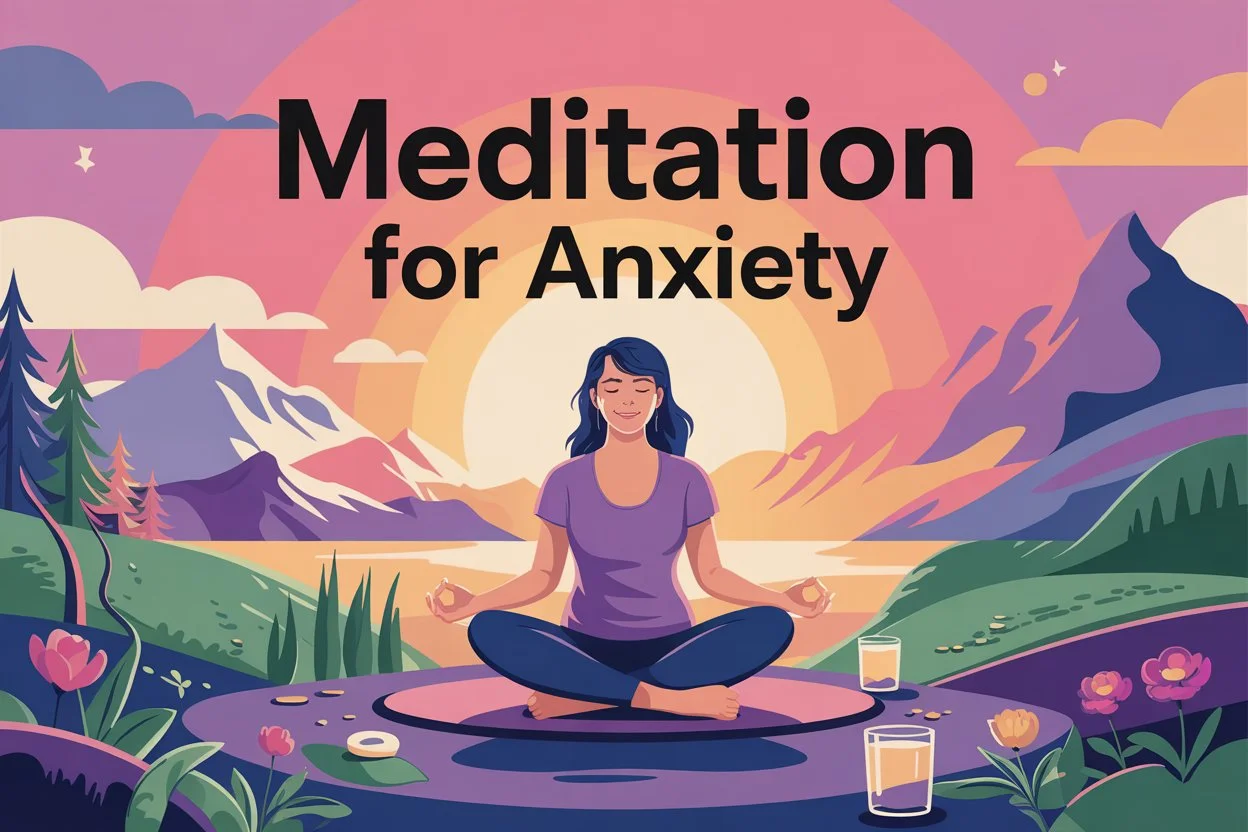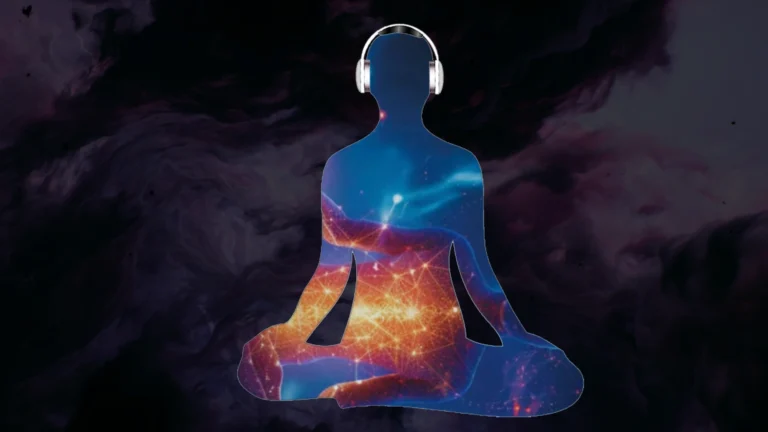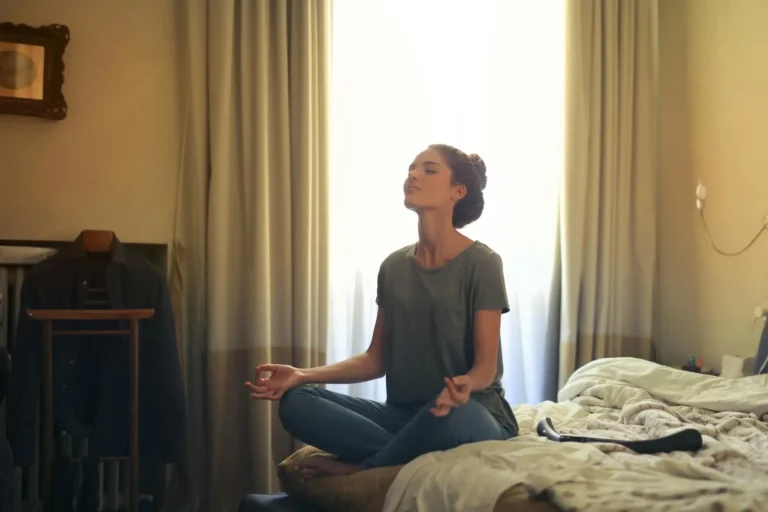Meditation for Anxiety: 8 Comprehensive Guide to Inner Peace
Understanding the Connection Between Meditation and Anxiety Relief
Anxiety is a common condition that affects millions globally, causing distress, fear, and overwhelming worry. Meditation for anxiety is a time-tested solution that offers profound mental, emotional, and physiological benefits. By integrating meditation into our daily lives, we can significantly decrease anxiety levels and foster a resilient, peaceful mind.
Table of Contents
How Meditation Targets the Root Causes of Anxiety
Anxiety often stems from overactive thoughts, fear of the future, or unresolved past experiences. Meditation acts as a calming balm, quieting the mind and providing clarity. Through focused breathing, body awareness, and mindfulness techniques, meditation helps deactivate the brain’s fear center, the amygdala, while strengthening the prefrontal cortex, responsible for rational thinking and emotional regulation.
Scientific Evidence Supporting Meditation for Anxiety
Numerous studies confirm the efficacy of meditation in anxiety management. Research published in JAMA Internal Medicine shows that mindfulness meditation can significantly reduce symptoms of anxiety, depression, and pain. Functional MRI scans reveal that consistent meditation practice alters brain structure and function, enhancing emotional control and reducing stress hormones like cortisol.
Types of Meditation Best Suited for Anxiety
Mindfulness Meditation
Mindfulness meditation involves observing thoughts, sensations, and emotions without judgment. It teaches us to remain present, reducing the habit of ruminating over worries and future fears.
Loving-Kindness Meditation
This practice cultivates compassion towards ourselves and others, helping diminish self-criticism, a major contributor to anxiety.
Body Scan Meditation
By systematically focusing on each part of the body, body scan meditation promotes deep relaxation and increased awareness of physical tension related to anxiety.
Guided Visualization
Guided visualization involves imagining serene landscapes or positive scenarios, helping shift the mind away from anxious thoughts toward peaceful imagery.
Step-by-Step Guide to Start Meditation for Anxiety
1. Find a Quiet Space
Choose a tranquil environment free from interruptions. Dim the lights, silence your phone, and ensure a comfortable temperature.
2. Assume a Comfortable Position
Sit or lie down in a position that keeps your back straight yet relaxed. You may sit cross-legged on a cushion or upright in a chair.
3. Focus on Your Breathing
Gently close your eyes and bring attention to your breath. Feel the air entering and exiting your nostrils. If your mind wanders, acknowledge the thought and return to your breath.
4. Acknowledge and Release Anxious Thoughts
Instead of fighting intrusive thoughts, observe them neutrally. Label them as “thinking” and refocus on your breathing or body sensations.
5. Practice Consistently
Start with 5-10 minutes daily, gradually increasing to 20-30 minutes. Consistency is crucial for reaping long-term benefits.
Common Challenges When Meditating for Anxiety (and How to Overcome Them)
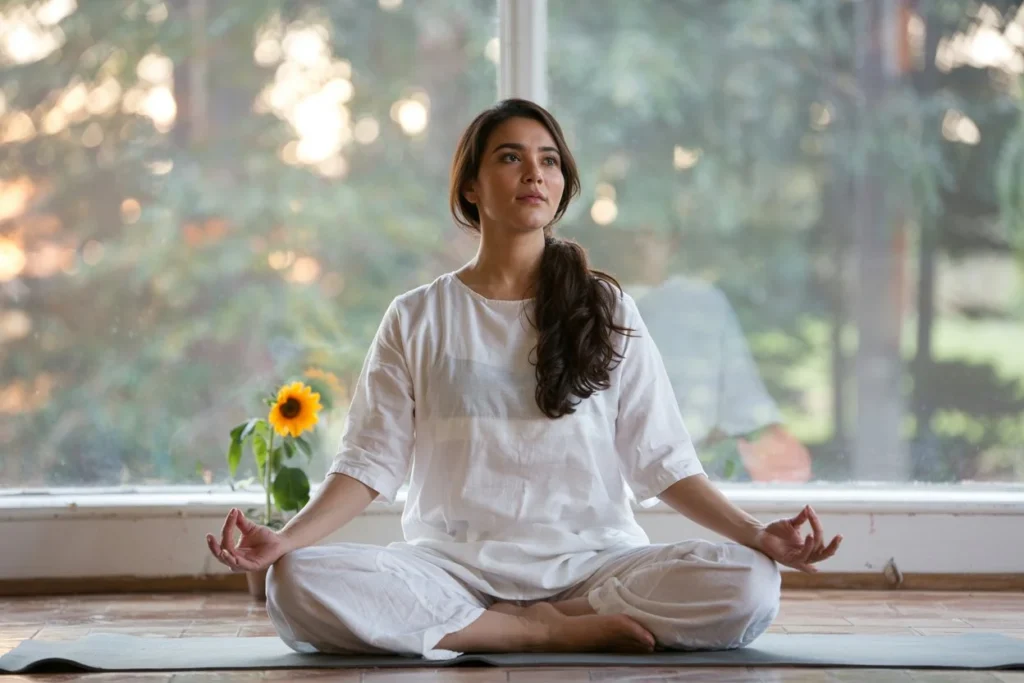
Restlessness and Impatience
It is normal to feel restless initially. Overcome this by setting small, achievable goals and gradually increasing meditation time.
Intrusive Thoughts
Rather than resisting thoughts, observe them with detachment. Every time you return to your breath, you are strengthening your mind.
Self-Judgment
Avoid judging your meditation performance. Meditation is not about achieving a blank mind but about becoming aware of where your attention is.
The Benefits of Daily Meditation for Anxiety Management
Reduced Stress Levels
Daily meditation lowers cortisol production, leading to a decrease in overall stress levels.
Improved Emotional Regulation
Meditation strengthens emotional resilience, helping us respond thoughtfully rather than react impulsively to stressors.
Enhanced Self-Awareness
Through regular practice, we develop deeper self-understanding and emotional intelligence, crucial for managing anxiety effectively.
Better Sleep Quality
Meditation calms the nervous system, facilitating faster sleep onset and improving sleep quality, both critical for anxiety management.
Incorporating Meditation into Your Daily Routine
Morning Meditation
Starting the day with meditation sets a positive tone and enhances focus and emotional stability throughout the day.
Midday Reset
Taking a few minutes at midday to meditate can alleviate accumulated stress and restore mental clarity.
Evening Wind-Down
Evening meditation helps release the day’s stress and prepares the mind and body for restful sleep.
Recommended Tools and Resources for Meditation
Apps
- Headspace: Offers guided meditations tailored for anxiety.
- Calm: Features breathing exercises, sleep stories, and anxiety-reducing meditations.
- Insight Timer: Provides free access to thousands of guided sessions.
Books
- “The Miracle of Mindfulness” by Thich Nhat Hanh: A practical guide to mindfulness meditation.
- “Wherever You Go, There You Are” by Jon Kabat-Zinn: Insights into incorporating mindfulness into daily life.
Online Courses
- Mindfulness-Based Stress Reduction (MBSR) programs, available online, offer structured learning for anxiety management through meditation.
Why Meditation for Anxiety Is Essential in Today’s Fast-Paced World
In our hyperconnected and fast-paced world, chronic stress and anxiety have become almost unavoidable. Meditation for anxiety serves as an antidote to the chaos, allowing individuals to reconnect with their inner peace amidst external pressures. Regular meditation practice helps slow down racing thoughts, cultivate mental clarity, and build an emotional sanctuary resilient to daily stressors.
Meditation for Anxiety: How Long Until You See Results?
Many individuals wonder how quickly they will experience relief after beginning meditation for anxiety. While some report immediate calmness after a single session, lasting benefits typically emerge after consistent practice over several weeks. Studies indicate that practicing mindfulness meditation for just 10 minutes a day for eight weeks can produce measurable reductions in anxiety symptoms, emphasizing the power of dedication and patience.
The Future of Mental Health: The Growing Role of Meditation for Anxiety
As society becomes more aware of the importance of mental health, meditation for anxiety is increasingly recognized as a primary tool for emotional wellness. Hospitals, schools, and workplaces are integrating meditation programs to support mental resilience. The future promises greater accessibility to meditation resources, more scientific research confirming its benefits, and a shift towards preventative mental health care where meditation plays a central role.
meditation for anxiety is a powerful practice on its own, combining it with yoga can significantly amplify the mental, emotional, and physical benefits, creating a holistic defense against anxiety disorders. Yoga, when paired with meditation, offers a complete mind-body approach that not only manages but also actively prevents the development of anxiety.
Yoga is an ancient practice that integrates physical postures (asanas), controlled breathing techniques (pranayama), and meditation to harmonize the mind and body. Each component of yoga targets anxiety from different angles. The physical postures release built-up tension and stimulate the parasympathetic nervous system, which counters the fight-or-flight response typically triggered by stress. Meanwhile, the breathing exercises calm the nervous system and encourage mindfulness, preparing the mind for deeper meditation.

Meditation for anxiety plays a crucial role in the yoga practice by fostering introspection, present-moment awareness, and emotional regulation. After engaging in a yoga sequence, the body becomes more relaxed and receptive, allowing meditation to penetrate deeper levels of consciousness. This heightened state of relaxation enhances the effectiveness of meditation, making it easier to let go of intrusive, anxious thoughts.
Scientific studies support the combination of yoga and meditation in anxiety management. Research published in the Journal of Psychiatric Practice demonstrates that yoga significantly reduces anxiety symptoms, particularly when combined with mindfulness meditation. Another study in Frontiers in Psychiatry found that participants who practiced yoga alongside meditation experienced lower cortisol levels, reduced heart rate variability linked to anxiety, and improved mood stability.
A typical session that integrates yoga and meditation for anxiety may start with a series of gentle, restorative yoga poses such as Child’s Pose (Balasana), Cat-Cow Stretch (Marjaryasana-Bitilasana), and Legs-Up-The-Wall Pose (Viparita Karani). These poses activate relaxation responses in the body and prepare the mind for meditation. Following yoga, practitioners can transition into seated meditation, focusing on breath awareness, body scanning, or loving-kindness meditation to solidify the calming effects.
Practicing yoga before meditation also helps address a major challenge faced by individuals struggling with anxiety—restlessness and agitation. Physical movement releases pent-up nervous energy, making it easier to sit still during meditation. Furthermore, mindful movement during yoga teaches individuals to stay connected to their bodies, cultivating a present-moment focus that is crucial in alleviating anxiety.
Over time, the regular combination of yoga and meditation for anxiety creates profound mental resilience. It retrains the brain to respond to stressors more calmly and adaptively. This proactive approach not only manages current symptoms but fortifies the mind against future episodes of anxiety.
We recommend practicing yoga and meditation together at least three to four times per week for noticeable results. For those experiencing severe anxiety, starting with professional guidance—such as a certified yoga instructor specializing in mental health—is highly beneficial.
Incorporating both yoga and meditation for anxiety into daily routines establishes a sustainable, natural pathway to peace. Unlike medication, which often addresses only symptoms, the combination of these ancient practices works to heal anxiety at its root, leading to long-lasting emotional well-being and a profound sense of inner security.
Enhance Your Practice with Meditation Music Kits Recommended by Gurus and Expert Meditators
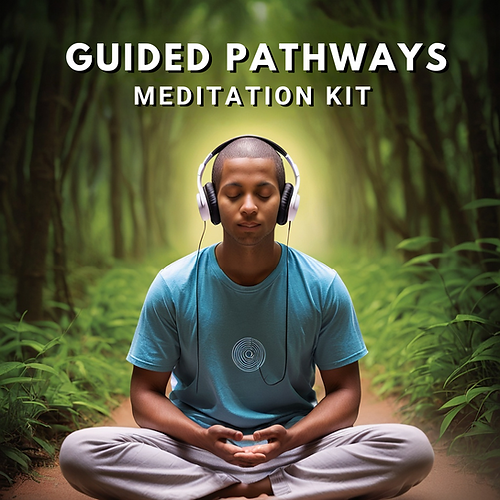
In the journey of mastering meditation for anxiety, creating the right environment plays a crucial role in maximizing the benefits of your practice. Among the most highly recommended tools by meditation gurus and seasoned practitioners is the use of a meditation music kit. Carefully curated soundscapes, ambient tones, and healing frequencies are known to deepen meditation, making it easier to achieve a calm, centered state of mind that is essential for overcoming anxiety.
Gurus across different traditions emphasize that the right meditation music not only enhances relaxation but also triggers the brain’s alpha waves, responsible for promoting deep mental clarity and tranquility. Soft binaural beats, nature sounds, and specific harmonic frequencies guide the mind away from stress and into states of profound peace. This support is especially critical for beginners or anyone struggling with heightened anxiety levels, where intrusive thoughts can easily disrupt meditation efforts.
Our Meditation Music Kit is specifically designed to support meditation for anxiety.
Unlike random playlists found online, our meditation music has been carefully selected, tested, and approved by experienced meditation teachers, sound therapists, and mindfulness coaches. It’s a complete toolkit for anyone serious about mastering meditation for anxiety and transforming their mental and emotional well-being.
Frequently Asked Questions (FAQ) About Meditation for Anxiety
What is Meditation for Anxiety?
Meditation for anxiety is the practice of using mindfulness, breathing techniques, guided imagery, and mental focus to manage and reduce anxiety symptoms. It trains the mind to remain anchored in the present moment, calming the nervous system and decreasing the intensity of anxious thoughts and emotions.
Why is Meditation Effective for Anxiety?
Meditation alters brain chemistry by reducing cortisol levels, the hormone linked to stress. It strengthens areas of the brain responsible for emotional regulation and logical thinking, like the prefrontal cortex, while calming overactive areas like the amygdala. Through consistent practice, meditation for anxiety helps build resilience against stressors and fosters a greater sense of inner peace.
How to Meditate for Anxiety?
To practice meditation for anxiety, follow these simple steps:
–Find a Quiet Space: Minimize distractions and sit comfortably.
–Focus on Your Breath: Observe each inhalation and exhalation.
–Allow Thoughts to Pass: Instead of engaging with anxious thoughts, acknowledge them and gently return focus to your breath.
–Use a Guided Meditation: Beginners may benefit from recorded sessions designed to address anxiety specifically.
–Practice Daily: Even 10-15 minutes a day can yield significant improvements over time.
Conclusion: Unlock Inner Peace Through Meditation
Meditation is a powerful, accessible tool for overcoming anxiety and achieving emotional freedom. By cultivating a consistent practice, we can profoundly transform our inner world, build emotional resilience, and embrace life with greater calm and confidence. Let us commit to this life-enhancing journey and witness the transformative power of meditation in managing and ultimately overcoming anxiety.

